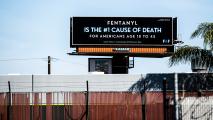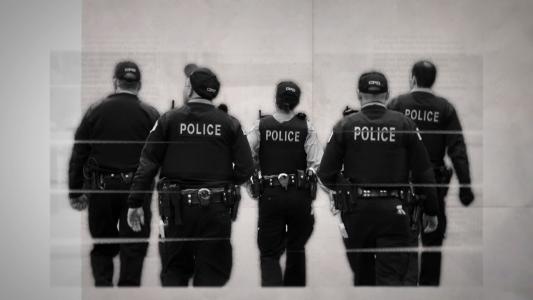One summer night in 2006 in Newark, New Jersey, two police officers allegedly beat Cornell Pendergrass outside of his apartment complex so badly his jaw needed to be wired shut for several weeks.
Pendergrass claims he was trying to break up a fight between his sister and three other women when the two police officers, Michael Walker and Larry Brown, showed up. According to a lawsuit that Pendergrass filed in federal court, Walker shoved Pendergrass and punched him so hard that he was knocked to the ground. When Pendergrass tried to get up, he claimed Walker hit him again. The officers then turned their aggression on a woman at the scene who was filming the officers and they assaulted her too, according to the lawsuit. Pendergrass wasn’t arrested and he alleged that Walker came back to the apartment and offered him a bribe to “forget about everything.”
That lawsuit was eventually settled out of court, but was only one of many instances of alleged abuse at the hands of Newark police that the New Jersey chapter of the American Civil Liberties Union (ACLU) reported in 2010 to the U.S. Department of Justice in its call for an investigation into the Newark Police Department (NPD). For decades this department has had an antagonistic relationship with the city’s majority African-American population.
The Justice Department’s ensuing investigation revealed problems with the NPD not unlike those seen in communities throughout the United States, namely heavy-handed tactics by officers that tend to be disproportionately used against people of color.
The investigation also led to a raft of reforms for policing in Newark, such as the appointment of a federal monitor, the implementation of better safeguards against theft, the use of body-worn cameras and the establishment of a civilian oversight board, an idea that has been embraced by an increasing number of communities in recent years as the general public’s awareness of the need for police reform has grown.
Some 200 communities across the United States have some form of a civilian oversight board, said Liana Perez, director of operations for the National Association of Civilian Oversight of Law Enforcement. That represents a small sliver of the roughly 18,000 law enforcement agencies operating around the country, but she said that interest in establishing oversight entities has sprouted up in towns and cities that don’t already have them. For those that already do have them, board members have turned to elected leaders to see if they can increase their authority, such as by arming themselves with subpoena power.
“For the community and even for the elected officials and the police chiefs, it’s another tool to be interactive with the community having those community connections for when something happens,” Perez said. “Something is going to happen eventually.”
In Newark, reform advocates had called for the establishment of a civilian oversight entity long before the ACLU petitioned the Justice Department about police brutality. According to Alex Shalom of ACLU-New Jersey, this has been an issue at least as far back as the 1960s when riots broke out in response to another incident of police brutality. And activists even at that time were saying that the police needed policing he said.
“Getting change in law enforcement is sometimes arduous and difficult work,” Shalom said, “conditions were ripe when we eventually got Newark to agree to the civilian review board.”
In 2016 Newark got what is considered the gold standard model of a civilian review board. When it was created, Newark’s 11-member Civilian Complaint Review Board (CCRB) was armed with subpoena power, investigative authority and the ability to make disciplinary rulings against officers that would stick unless the city’s public safety director finds “clear error” in the board’s investigation. Additionally, it was the first CCRB to begin operations in New Jersey.
“Now that we’ll have a permanent CCRB in Newark, my children have a better chance of getting an important layer of protection for their rights that I didn’t have,” said community advocate Laquan Thomas in an ACLU news release following the Newark City Council’s vote to establish the board. “I don’t know when the abuse in our community is going to stop, but I do know that now, with a civilian oversight board passed into law, we’re closer to that point.”
However, the celebrations didn’t last long. Almost immediately after it was created, Newark’s police union, the Fraternal Order of Police, Lodge No. 12, launched a legal attack on the CCRB, arguing that giving the board subpoena powers runs afoul of state law and that the ultimate authority to decide officer discipline must lie with the police chief.
Last year, New Jersey Superior Court Judge Donald Kessler sided with the police union, effectively defanging Newark’s nascent CCRB. He credited the advocates for their passion on the issue but said that because some of the board members belong to activist groups, some members might call for officer discipline to settle a political vendetta.
“I’m not trying to impugn the integrity of any of the organizations involved in this case whose participation is heartfelt and laudable,” Kessler said in a bench ruling, which was broadcast on New Jersey’s public television station, NJTV. “The potential for political mischief with this body is evident.”
While it instituting this reform has been a challenge for Newark, some cities have had a form of civilian oversight for years.
The initial steps to create the New York City Civilian Review Board, which investigates the country’s largest police force, were taken in the 1950s; the board fell into its current iteration in 1993—it is fully independent and all-civilian. While disciplinary decisions for NYPD officers ultimately lie with the police commissioner, the NYC CCRB has acted as prosecutor in NYPD disciplinary proceedings.
The NYC CCRB has a staff of about 170, of whom half work on receiving and investigating civilian complaints, and a budget of more than $17 million. It also acts as a prosecutor’s office in administrative proceedings for officers, which Perez says is a rare power for a CCRB.
The NYC CCRB acted as prosecutor in disciplinary proceedings for Daniel Pantaleo, the New York City police officer who was seen in the now infamous video putting Eric Garner in the chokehold which led to his death—a case that became joined the shooting death of Michael Brown in Ferguson, Missouri and a number of other cases to become a cause célèbre for police reform advocates.
The NYC CCRB also has what advocates consider a key component for an effective oversight board: independence from the law enforcement agency they are investigating. Another oft-cited example of a strong independent board is Washington, D.C.’s Office of Police Complaints, which is made up of five members, four of which must have no ties to law enforcement. The board also has access to all of the Metropolitan Police Department’s footage collected from body-worn cameras.
Richard Emery, a New York attorney who formerly served as director of New York City’s CCRB, said that a board’s effectiveness also depends not only on its funding levels—staffing the entities with attorneys and investigators isn’t cheap—but how quickly a board is able to obtain information from a law enforcement agency.
“You have to be able to get everything the police have, plus you have to be able to go interview all the people yourself,” Emery said. If investigations are mired in “bureaucratic malaise,” Emery said, and beset by delays that make them drag on longer than two weeks, the community may start to lose faith that the boards can do their jobs.
Emery said that during his tenure, New York City’s CCRB wasn’t as effective as it could have been with the powers it had, though he says it’s difficult to point to a set of statistics that indicate whether or not an oversight board is doing an effective job, except for perhaps the number of complaints it receives and anecdotal evidence from community members who give feedback about their interactions with cops.
Peter Moskos, former Baltimore cop and an associate professor at the John Jay College of Criminal Justice, said he hasn’t come across any hard evidence that communities with civilian oversight boards are benefitting in some easily measurable way.
The vast majority of American cities don’t have formal oversight boards and no two cities are the same—what works in Pittsburgh might not necessarily work well in Eugene, Oregon, Moskos said, but at the very least civilian review boards can bring a measure of accountability and transparency to policing that may encourage officers themselves to think more about following the rules.
“It’s a flawed concept that’s better than nothing,” Moskos said.
Moskos also said that, while he is generally supportive of the idea of a formal body that is tasked with keeping police departments transparent, the idea of a board of civilians without specific expertise telling highly trained officers what to do doesn’t sit right with him.
“I don’t mind having my students judging me as a professor, but I don’t want a high school dropout to judge me,” he said.
And it remains to be seen what a CCRB—especially one with diminished powers—will be able to do for Newark residents. For the time being, the city is waiting for its day to fight to overturn Kessler’s ruling and restore the CCRB’s powers before a New Jersey state appellate court.
In the ACLU’s petition for the Justice Department to come and investigate the Newark police, the organization also included a 2006 incident in which resident Mary Cheeseboro reportedly found herself at a family barbecue that turned violent at the hands of police who had stopped a carload of juveniles nearby and began assaulting them. When Cheeseboro spoke up to tell the officers to stop, the officers allegedly turned their sights on her and her daughters, handcuffing them, throwing them to the ground and using pepper spray on them.
And in an incident from 2007, Newark police officers Antonio Tavares and Anthony Matos reportedly stopped a 15-year-old and ordered him to admit that he had been tampering with cars—if he didn’t, they said, they would throw him over a bridge. When a supervisor told Tavares and Matos to take the juvenile home, they allegedly instead took him to a secluded area, beat him, urinated on him and ditched him.
In 2014, after the Justice Department completed its report, it released a scathing assessment of the Newark police department and how it treats the people it’s sworn to protect. The department found that, in some 75 percent of pedestrian stops by Newark officers, officers failed to give a legal reason for doing so; in thousands of cases, officers said they stopped individuals who were merely “loitering” or “wandering,” and they tended to happen more often to people from minority populations than white residents.
What’s more, the Justice Department found, in its review of cases in which officers used force, more than 20 percent appeared unreasonable. It also found evidence that some officers, particularly those in the Newark Police Department’s gang and narcotics units, as well as a prisoner processing unit, had been stealing money and property from citizens.
The city’s CCRB was created as part of a settlement agreement between the city and the Justice Department. Shalom of the ACLU said he and other advocates have no delusions that a CCRB—even one with its powers restored—will be a “cure all” for decades of strife between Newark residents and the officers sworn to protect them, though he still believes that the creation of the CCRB in Newark and the other changes taking place there can serve as a model for other American cities to follow.
“I think we’ve done that and now the question is can we get the court to let us continue this,” Shalom said.
Perez, of NACOLE, also concedes that it’s difficult to single out one metric as an indicator that a civilian review board is effectively serving a community: the number of protests that a city has on its streets over police violence, for example, isn’t exactly a good way to measure if oversight boards are taking police to task.
Nevertheless, Perez said that oversight boards benefit their communities by helping residents build ties with officers while asking tough questions of local leaders when policing issues come to light.
“Even though you can’t measure it numbers or statistics, it’s a check and balance on the system,” Perez said.





